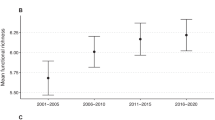Summary
The structure of the food-web at the flower-herbivore interface was examined along a transect of fourteen communities across central California. All results are commensurate with the hypothesis that in most environments there is selective pressure towards specialization. However, it is only in the most predictable or stable environments that the resultant diminishment of behavioral and genetic flexibility is in a sense “permitted” by subsequent natural selection. In the most extreme environments, behavioral specialization may be a necessary prerequiste permitting briefly thriving ephemeral populations which must recolonize frequently. The data results indicate: 1) Total species number increases with stability and predictability of the climate; 2) As the climate ameliorates, niche-specialization is a progressively more successful strategy; 3) The percentage of niche-specialized species of both plants and flower-feeding herbivores increases in the most severe environments at the expense of the more moderately specialized species; 4) Energetic flow chart redundancy increases in extreme environments; 5) Especially important to an understanding of pollination interactions is the fact that similar physiognomic communities at very different altitudes are in all cases much more similar than different community types within a research site.
Similar content being viewed by others
References
Baker, H.G., Stebbins, G.L.: The genetics of colonizing species. Symposium on general biology, vol. I, 588 pp., Int. Union Biol. Sci. New York Academic Press 1965
Chabot, B.F., Billings, W.D.: Origin and ecology of the Sierran alpine vegetation. Ecol. Monogr.42, 164–199 (1972)
Clausen, J.: The Harvey Monroe Hall Natural Area. Carnegie Inst. Washington Publ. No. 459, 48 pp. (1969)
Colwell, R.K.: Ecological specialization and species diversity of tropical and temperate arthropods. University of Michigan, Ph.D. Thesis (1970)
Coulter, M.: Flora of the Farallon Islands, California. Madrono21, 131–137 (1971)
Faegri, K., van der Pijl L.: Principles of pollination ecology, 248 pp. Toronto: Pergamon Press 1966
Felton, E.L.: California's many climates, 169 pp. Palo Alto: Pacific Books 1965
Ferris, R.S.: Flowers of Point Reyes National Seashore, 119pp. Berkeley: University of California Press 1970
Grant, V.: Origin of adaptations, 606 pp. New York: Columbia University Press 1963
Hartley, P.H.T.: An ecological study of the feeding habits of English titmice. J. anim. Ecol.22, 261–288 (1953)
Heinrich, B., Raven, P.H.: Energetics and pollination ecology. Science176, 597 (1972)
Heithaus, E.R.: Species diversity and resource partitioning in four neotropical plant-pollinator communities. Ph. D. Thesis, 148 pp., University of Michigan, Microfilm Services of Stanford University (1973)
Heithaus, E.R.: The role of plant pollinator interactions in determining community structure. Ann. Mo. Bot. Gdn.61, 675–691 (1974)
Hendrickson, J., Ehrlich, P.R.: An expanded concept of “species diversity”. Notulae Naturae439, 1–6 (1971)
Kevan, P.G.: High arctic insect-flower relations: The inter-relationships of arthropods and flowers at Lake Hazen, Ellesmere Island, N.W.T., Canada. Ph. D. Thesis, 399 pp., University of Alberta (1970)
Kruckeberg, A.R.: The biology of serpentine soils. Ecology35, 267–274 (1954)
Linsley, E.G.: The ecology of solitary bees. Hilgardia27, 543–599 (1958)
Lloyd, M., Gelardi, R.J.: A table for calculating the equitability component of species diversity. J. Anim. Ecol.33, 217–226 (1964)
MacArthur, R.H.: Patterns of species diversity. Biol. Rev.40, 510–533 (1965)
Margalef, R.: La teoria de la informacion en ecologia. Memorias de la real Academia de Ciencias y Artes, vol. 33, p. 373–449 (1957)
Milliman, J.D., Ernery, K.O.: Sea levels during the past 35000 years. Science162, 1121–1123 (1968)
Moldenke, A.R.: Studies on the species diversity of California plant communities. Ph. D. Thesis, University of Michigan, Microfilm Services of Stanford University (1971)
Moldenke, A.R.: A contribution towards a chromosome atlas of the California flora. Int. Biol. Prog. Origin and Structure of Ecosystems. Tech. Rept. No. 74-10, 74-22, 74-23 (1974)
Moldenke, A.R., Neff, J.L.: Studies on the species diversity of California plant communities. Part II. Int. Biol. Prog. Origin and Structure of Ecosystems. Tech. Rep. No. 74-13, 233 pp. (1974)
Moldenke, A.R., Neff, J.L.: Studies on the species diversity of California plant communities. Part III. Int. Biol. Prog. Origin and Structure of Ecosystems. Tech. Rep. No. 74-14, 179 pp. (1974)
Moldenke, A.R., Neff, J.L.: Pollination ecology as a tool for study ecosystemic organization: Convergent evolution in Chile and California. In preparation
Porter, D.: The vascular plants of the Jasper Ridge Biological Experimental Area of Stanford University, Mimeographed, 28 pp. (1962)
Simpson, E.H.: Measurement of diversity. Nature (Lond.)161, 688 (1949)
Stebbins, G.L.: Chromosomal evolution in higher plants, 216 pp. Menlo Park: Addison-Wesley Publ. 1971
Stebbins, E.H., Babcock, E.B.: The effect of polyploidy and apomixis on the evolution of species inCrepis. J. Hered.30, 519–530 (1939)
Thomas, J.H.: Flora of the Santa Cruz Mountains of California, 434 pp. Stanford: Stanford University Press 1961
Wittaker, R.H.: Vegetation of the Siskyou Mountains of Oregon and California. Ecol. Monogr.30, 279–338 (1960)
Zohary, D.: Colonizer species in the wheat group, p. 403–423. In: H. G. Baker, G. L. Stebbins (1965), op. cit.
Author information
Authors and Affiliations
Rights and permissions
About this article
Cite this article
Moldenke, A.R. Niche specialization and species diversity along a California transect. Oecologia 21, 219–242 (1975). https://doi.org/10.1007/PL00020263
Received:
Issue Date:
DOI: https://doi.org/10.1007/PL00020263




